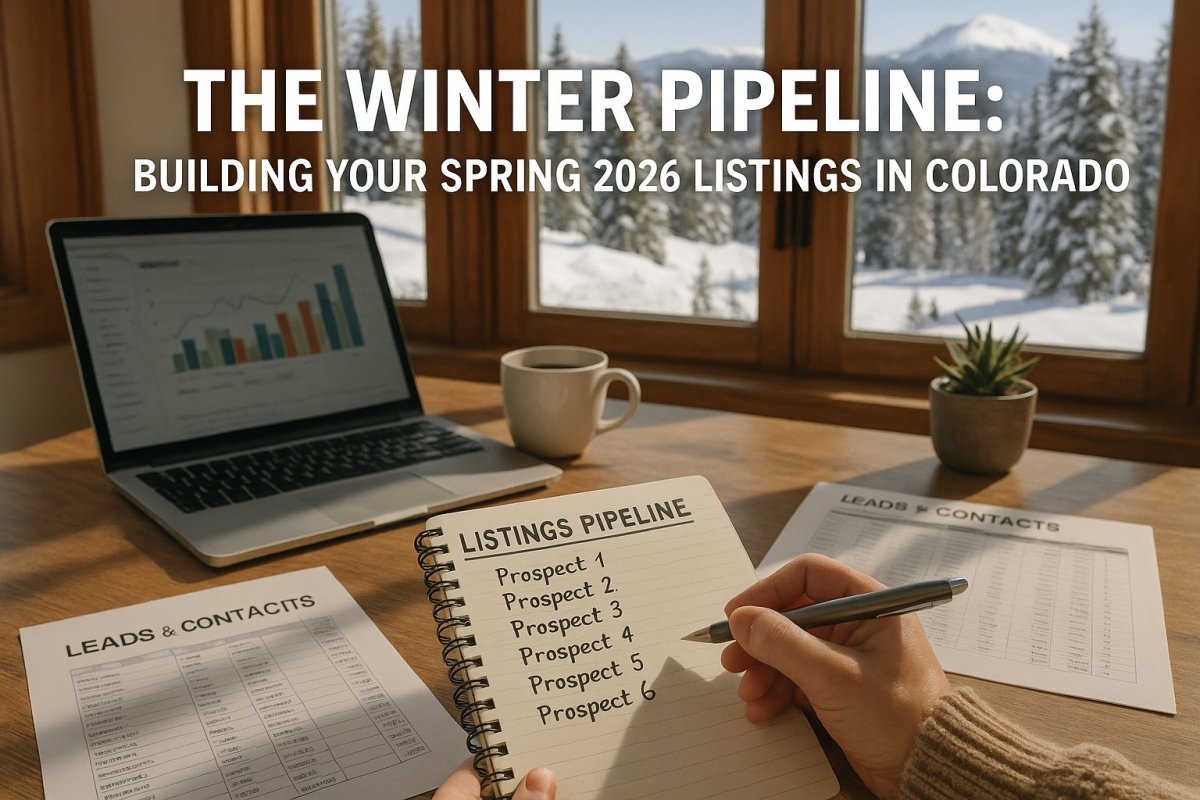Executive Summary: Colorado enters 2026 with a market defined by normalization—not a rewind to the 3% era. Our base case assumes mortgage rates glide toward the low–mid 6s while the “lock-in” effect gradually loosens where life events and affordability improvements intersect. Listing supply should improve modestly (driven by ≥4% mortgage cohorts, select investors, and life-event sellers), while price growth remains measured and micro-market specific. Denver Metro will behave as a chain of micro-markets rather than a monolith; Colorado Springs tracking strong PCS/admissions flows; Northern Colorado responding most to affordability signals and investor rebalancing. The pros who win 2026 will work a dual mandate: (1) micro-market precision for pricing and timing, and (2) persona-level targeting to convert the right sellers at the right moment. This outlook packages scenarios, numbers, and a practical playbook so you can operate with clarity from January through December 2026.
1) How to use this outlook
This is not a generic “prices up or down” memo. It’s a decisions framework for Colorado agents, teams, and brokers who need to make concrete calls on where to spend time, how to guide sellers, and how to compose offers that clear in a normalization cycle. Read together with our guides on "The Locked-In Effect," building "The Winter Pipeline," and "Mastering Micro-Markets."
2) The 2026 macro spine: rates, income, inventory
We anchor our outlook on three levers that most directly shape Colorado housing in 2026:
- Mortgage rates glide to ~6.0–6.4% by year-end in the base case (with temporary oscillations). This is not “cheap,” but it materially narrows the payment delta versus 2024–2025 highs.
- Household incomes continue mid-single-digit growth (Colorado’s employment base remains diverse: tech, aerospace/defense, healthcare, energy, higher ed), supporting steady absorbtion of well-priced listings.
- Listing supply improves modestly as (a) ≥4% mortgage cohorts re-enter, (b) life-event sellers transact, (c) select landlords exit, and (d) new-home deliveries add incremental choice.
Put together, 2026 looks like a “workmanlike” market: fewer distortions, more segmentation, and outsized opportunity for agents who play the micro edges intelligently.
3) Scenario map: rates × supply × demand
We model Colorado outcomes under three interest-rate contours. Use this table to translate macro noise into local game plans.
| Scenario | 30-yr Fixed (YE-2026) | Listing Supply vs. 2025 |
Buyer Formation | Price Trajectory | Best Opportunities | Agent Tactics |
|---|---|---|---|---|---|---|
| Base | ~6.0–6.4% | +5–10% | Steady to +5% | +1–3% statewide; wider by ZIP | ≥4% cohorts; heirs; HELOC squeeze; condo/TH with total-cost pressure | Micro-market pricing; targeted concessions/buydowns; life-event pipelines |
| Bull | ~5.6–5.9% | +10–15% | +8–12% | +3–5% (tight cells stronger) | Move-ups re-start; investor rotations; entry-level surges north corridor | Accelerate launches; pre-wire lenders; capture trade-ups with list-then-buy |
| Bear | ~6.6–7.0% | 0 to +3% | Flat to −3% | −1% to +1% (spread by cell) | Life-event sellers dominate; tired landlords; estate sales | Price realism; heavy use of credits; longer DOM planning; investor buyer networks |
Read it like a dashboard: a two-to-four-tenths move in rates can swing buyer formation disproportionately in entry and mid bands (Thornton–Brighton–Greeley corridor first, then selected south suburbs), while higher-equity segments transact on life fit, not coupon alone.
4) Churn by mortgage cohort: who actually moves in 2026?
Churn won’t “snap back” uniformly. We expect the following relative contributions to 2026 listings:
- ≥4% mortgage holders: Largest incremental share of new listings as the payment delta narrows; sensitive to buydown math and credits.
- Free-and-clear owners: Steady, life-event-led supply (downsizing, relocation, estates). Not rate-sensitive; highly service-sensitive.
- <4% mortgage holders: Remain sticky; they list when life events (divorce, health, inheritance) or total-cost shocks (HOA/insurance/capex) dominate.
Translate this to action by aligning outreach to the cohorts most likely to transact in your farm—see our guide on "The Locked-In Effect" for segmentation tactics and scripts.
5) Denver Metro: a mosaic, not a monolith
Think in micro-markets:
- South suburban detached (Centennial, Highlands Ranch, Littleton): Family demand and school-zone premiums support measured price gains in base/bull cases; moderate inventory build is healthy. Launch windows matter.
- Urban condo corridors (Downtown, DTC, parts of Aurora): HOA dues and insurance continue to weigh on monthly cost; expect higher concessions, strategic buydowns, and investor exits in pockets. Listing opportunities from owners feeling dues fatigue.
- North corridor entry/mid detached (Thornton → Brighton → Greeley): Highest elasticity to rate moves; multiple-offer probability returns first here under the bull path; investor rebalancing can inject supply.
Running Denver without a micro-market OS is guesswork. Build the weekly signal stack described in our "Mastering Micro-Markets" playbook and attach seller personas per cell.
6) Colorado Springs: certainty, VA assumability, and PCS cadence
Springs remains a logistics-first market with meaningful VA loan penetration. In 2026:
- PCS & defense hiring should keep a baseline of relocations. Many sellers are deadline-driven—certainty > price peak.
- VA assumability is an overlooked selling feature; a 3% assumable can transform buyer demand. Train listing presentations to surface it.
- HELOC squeeze + retirees generates a steady stream of motivated sellers; free-and-clear share is meaningful.
Agent edge: compress buyer payments via credits/buydowns on the purchase side; emphasize calendar control (rent-backs, bridge) on the sale side.
7) Northern Colorado: affordability pivots and estate throughput
NoCo behaves as a life-event + affordability switch. Watch:
- Estate/Heir pipelines (Fort Collins/Loveland/older tracts) — high-service, high-trust listings with strong spring absorption if prepped.
- Entry to mid bands — rate elasticity reigns. Small coupon moves unlock latent demand; buy-side buydowns outperform broad price cuts.
- Investor exits where capex or rent caps bite—target absentee owners with “make-ready + listing” bundles.
Heirs and tired landlords respond to concierge value more than postcard slogans; see our playbooks on "Why Out-of-State Heirs Are Motivated Sellers" and the "Investor Exit Wave."
8) Prices, rents, and days on market: likely trajectories
Prices: Base case +1–3% statewide with higher dispersion by ZIP/ptype; bull case +3–5% in tight detached cells; bear case flat to −1% with condo/TH corridors softer.
Rents: Stabilize with mild growth; new-unit deliveries cap rent spikes. Investor math pivots on maintenance/insurance more than rent alone.
DOM: Compresses in March–June under base/bull; stretches in bear scenario and in HOA-heavy assets.
| Asset / Cell | DOM Trend (Base) | Pricing Power | Concessions Use | Notes |
|---|---|---|---|---|
| Detached, family zones (south suburbs) | Down into spring; seasonal | Moderate+ | Targeted; buydowns optional | Condition premiums return; launch windows matter |
| Condo/TH, HOA-heavy corridors | Mixed; longer tails | Soft–Moderate | Common; buydowns effective | Make dues/assessment transparency central to strategy |
| Entry/mid detached (north corridor) | Improves fast with rate dips | Moderate+ | Buydowns potent | First to re-ignite in bull path |
9) Inventory mechanics: where supply actually comes from
Supply expansion in 2026 is composed rather than uniform:
- Life-event sellers (probate, divorce, relocation, accessibility) — winter discovery, spring listing (see "The Winter Pipeline").
- ≥4% mortgage holders leaning into improved monthly math with credits/buydowns.
- HOA/insurance shock segments in condo/TH; assessments and premiums push owners to list.
- Investor rebalancing where capex/insurability mute cash-on-cash; expect more 1031 conversations.
- New-home deliveries that absorb demand but also create ladders for move-ups (trade-up listings).
10) Risk matrix: what could derail or accelerate the base case
| Risk / Catalyst | Direction | Transmission | Agent Response |
|---|---|---|---|
| Rates spike >6.8% | Bear | Buyer pullback; DOM rise | Lean into life-event/estate; heavier credits; investor buyers |
| Rates undershoot <5.9% | Bull | Entry/mid surge; multiple offers | Accelerate launches; tighten pricing; manage appraisal gaps |
| Insurance premium shock | Mixed | Condo/TH sellers created; buyers selective | Payment framing; building-level transparency; lender pairing |
| Local policy/zoning shifts | Mixed | STR/ADU/permit changes alter demand/supply | Explainer memos; reposition marketing to new rules |
11) Financing strategies that win in 2026
- Targeted credits & buydowns: Aim at the buyer’s monthly pain point; 2-1s for entry; permanent buydowns for mid/upper bands.
- Assumability scanning: Especially in Springs; build a quick-check workflow on listing intake.
- Bridge & rent-back: De-risk list-then-buy for downsizers and move-ups; logistics sell.
- Equity-first positioning: For free-and-clear, structure to minimize friction (e.g., cash buy on replacement).
12) Personas with outsized impact in 2026
Use TimeToSell.AI to surface the exact households where these narratives fit:
- "How to Find Trapped Equity Downsizers" — long tenure, high equity, lifestyle fit issues; micro-market comps matter.
- "The HELOC Squeeze" — low-rate first + variable second; payment relief via exit and reset.
- "Why Out-of-State Heirs Are Motivated Sellers" — service-heavy, calendar-driven, high trust premium.
- Tired Landlord — capex/insurance fatigue; position liquidity + 1031 pathways.
13) County and corridor quick-takes (agent shorthand)
| Area | 2026 Lean | Seller Supply Sources | Buyer Sensitivities | Agent Focus |
|---|---|---|---|---|
| Denver County + older inner suburbs | Micro-split by block | Downsizers; condo dues fatigue | Total cost (HOA/insurance); walkability | Building/HOA transparency; pricing discipline |
| Arapahoe/Douglas (Centennial/HR/Littleton) | Steady to strong in base/bull | Move-ups; right-sizers | School calendars; commute time | Launch timing; pre-inspection; light credits |
| Adams/Weld (Thornton→Brighton→Greeley) | Rate-elastic upside | Investor exits; heirs; entry-level sellers | Payment sized; appraisal gaps | Buydown playbooks; fast-to-market packages |
| El Paso (Colorado Springs) | Certainty-driven | PCS; retirees; HELOC squeeze | VA assumability; timeline | Assumable audits; calendar control; relocation networks |
| Larimer/Boulder (Fort Collins/Loveland/Boulder) | Life-event + policy-sensitive | Heirs; high-equity move-downs | HOA/insurance; maintenance | Concierge estates; condition-first marketing |
14) Operations: your 2026 weekly OS (what great teams actually do)
- Monday: Update micro-market dashboard (MOI, DOM dist, price-cut %, pendings vs. new). Flag green cells (score ≥70) to target.
- Tuesday: Pull top 200 TimeToSell leads inside green cells; segment by persona; assign 3-touch sequences.
- Wednesday: Listing pipeline review: pricing posture by cell; concessions strategy; lender buydown menu.
- Thursday: Content drop: micro-market brief for sphere + targeted blog/short to support conversations (link internal posts).
- Friday: Vendor sprint: staging/handyman/photo for next week’s launches; title order checks; assumability audits.
15) Scripts that fit the 2026 moment
Locked-in owner (sub-4%): “Many of my 2026 sellers aren’t moving for the rate, they’re moving because the home no longer fits. If we can compress your buyer’s payment with credits, and you right-size with your equity, the math can still work comfortably.” (See the full "Locked-In Effect" playbook)
HOA-stressed condo owner: “Let’s make the dues part of our strategy, not a surprise. We’ll price to the active buyer pool and use a targeted buydown so the net monthly fits their budget.”
Heir/executor: “We’ll be your project manager on the ground, clean-out to closing, with weekly photo updates. I’ll send two plans: quick investor exit or MLS launch with likely net ranges and timelines.”
16) Pricing in a normalization cycle
- Price to live competition, not nostalgia: Anchor to the last 60–90 days + active set; weigh DOM tails.
- Use concessions to solve payment pain: A $12k credit can beat a $20k list-price cut for buyer utility.
- Stage for function: Single-level living, low maintenance, storage—show the lifestyle that matches the 2026 buyer.
17) What to track monthly (agent KPI pack)
- ZIP new vs. pendings (4-week moving) — supply/demand tilt.
- DOM distribution — detect overpricing pockets early.
- List-to-close ratio — pricing power reality check.
- Price-cut frequency — seller fatigue proxy.
- Concessions prevalence — payment friction barometer.
- HOA/insurance notices — seller creation events.
18) Putting it all together: a 2026 action plan
- Stand up your micro-market OS by January: Define cells, score weekly, narrate in one sentences.
- Aim your pipeline at likely sellers: Free-and-clear life-events, ≥4% cohorts with buy-side relief, HOA/insurance pressure points, heirs and tired landlords.
- Engineer payment comfort: Credits + buydowns pre-wired with lenders; assumability checks in Springs; bridge/rent-backs for logistics.
- Price like a pro: Live comps, transparency on total cost (dues/insurance), DOM-tail discipline.
- Operational cadence: Weekly dashboards → targeted outreach → production sprints → post-launch optimization.
The 2026 edge belongs to precise operators. Colorado will reward agents who see beyond averages, align strategy to micro-signals, and serve the right sellers at the right time. Activate your free TimeToSell.AI account and use your $100 lead voucher to pull a micro-targeted list of high-probability sellers in your territory. Then run the playbook above, consistently, and own your 2026.





